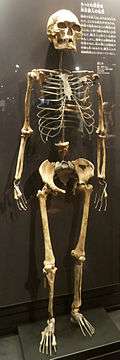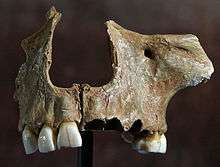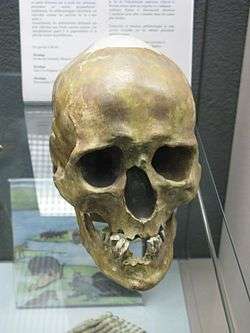List of human evolution fossils
| Part of a series on |
| Paleontology |
|---|
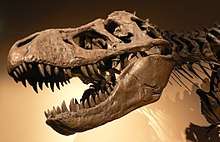 |
|
Organs and processes |
|
History of paleontology |
|
Branches of paleontology |
|
Paleontology Portal Category |
The following tables give an overview of notable finds of hominin fossils and remains relating to human evolution, beginning with the formation of the Hominini tribe (the divergence of the human and chimpanzee lineages) in the late Miocene, roughly 7 to 8 million years ago.
As there are thousands of fossils, mostly fragmentary, often consisting of single bones or isolated teeth with complete skulls and skeletons rare, this overview is not complete, but does show some of the most important finds. The fossils are arranged by approximate age as determined by radiometric dating and/or incremental dating and the species name represents current consensus; if there is no clear scientific consensus the other possible classifications are indicated.
Most of the early fossils shown are not considered direct ancestors to Homo sapiens but are closely related to direct ancestors and are therefore important to the study of the lineage. After 1.5 million years ago (extinction of Paranthropus), all fossils shown are human (genus Homo). After 11,500 years ago (11.5 ka, beginning of the Holocene), all fossils shown are Homo sapiens (anatomically modern humans), illustrating recent divergence in the formation of modern human sub-populations.
Late Miocene (7.2 – 5.5 million years old)
The chimpanzee–human divergence likely took place during about 10 to 7 million years ago.[1] The list of fossils begins with Graecopithecus, dated some 7.2 million years ago, which may or may not still be ancestral to both the human and the chimpanzee lineage. For the earlier history of the human lineage, see Timeline_of_human_evolution#Hominidae, Hominidae#Phylogeny.
| Name | Age | Species | Year discovered |
Country | Site | Discovered by | Now located at | |
|---|---|---|---|---|---|---|---|---|
 |
El Graeco | 7.2 Ma | Graecopithecus freybergi | 2017 (1944) | Greece, Bulgaria | Pyrgos Vassilissis, Azmakia | Böhme (Tübingen), Spassov (BAS) | Met, Athens; Tübingen, Germany |
 |
TM 266 (Toumai) | 7 Ma[2] | Sahelanthropus tchadensis | 2001 | Chad | Toros-Menalla, Djurab Desert | Alain Beauvilain, Fanone Gongdibe, Mahamat Adoum and Ahounta Djimdoumalbaye | N'Djamena (Chad), BEAC |
 |
BAR 1000'00 | 6 Ma[3] | Orrorin tugenensis | 2000 | Kenya | Lukeino | Martin Pickford, Kiptalam Cheboi, Dominique Gommery, Pierre Mein, Brigitte Senut, | |
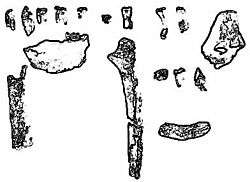 |
ALA-VP 1/20[4] | 5.65±0.15 Ma | Ardipithecus kadabba | 1997 | Ethiopia | Middle Awash | Yohannes Haile-Selassie | |
Pliocene (5.3 – 2.58 million years old)
Pleistocene
Lower Paleolithic: 2.58 – 0.3 million years old
Middle Paleolithic: 300,000 – 50,000 years old
Upper Paleolithic: 50,000 – 11,500 years old
Holocene (11,500 – 5,000 years old)
| Name | Age | Culture / association |
Year discovered |
Country | |
|---|---|---|---|---|---|
 |
Luzia | 11.5 ka[128] | Paleo-Indian | 1975 | Brazil |
| [129] | Cerro Sota 2[130] | 11 ka | 1936 | Chile | |
| "Satsurblia" | 10 ka | Caucasian Epipaleolithic (CHG)[125] | Georgia | ||
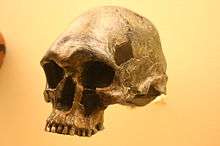 |
Kow Swamp 1 | 13–9 ka | 1968 | Australia | |
 |
Talgai Skull[131] | 10±1 ka | 1886 | Australia | |
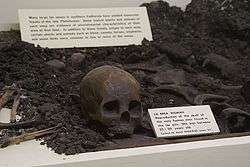 |
La Brea Woman | 10 ka | Paleo-Indian | 1914 | United States |
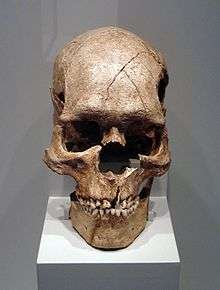 |
Combe Capelle | 9.6 ka (7600 BC)[132] | European Mesolithic | 1909 | France |
 |
Cheddar Man | 9 ka (7000 BC) | British Mesolithic | 1903 | UK |
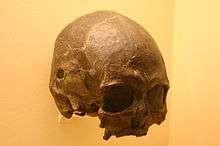 |
Tepexpan man | 8±3 ka | Paleo-Indian | 1947 | Mexico |
| "Loschbour"[133] | 8 ka (6000 BC) | European Mesolithic (WHG) | Luxembourg | ||
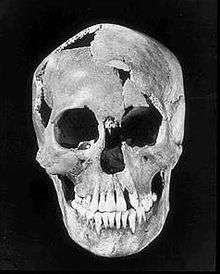 |
Minnesota Woman | 7.9±0.1 ka | Paleo-Indian | 1931 | Minnesota, United States |
| Lothagam 4b (Lo 4b)[134] | 7.5±1.5 ka[135] | 1965-1975 | Kenya | ||
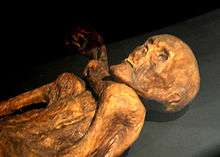 |
Ötzi | 5.3 ka (3300 BC) | European Neolithic | 1991 | Ötztal Alps, Italy |
See also
Further reading
- Gibbons, Ann. The First Human: The Race to Discover our Earliest Ancestor. Anchor Books (2007). ISBN 978-1-4000-7696-3
- Hartwig, Walter Carl (2002-04-11). Hartwig, Walter, ed. The Primate Fossil Record. Cambridge University Press (2002). Reprinted 2004. ISBN 978-0-521-08141-2 .
- Johanson, Donald & Wong, Kate. Lucy's Legacy: The Quest for Human Origins. Three Rivers Press (2009). ISBN 978-0-307-39640-2
- Jones, Steve; Martin, Robert D.; Pilbeam, David R (Editors). (1994). The Cambridge Encyclopedia of Human evolution. Cambridge University Press. ISBN 978-0-521-46786-5 (Note: this book contains very useful, information dense chapters on primate evolution in general, and human evolution in particular, including fossil history).
- Leakey, Richard & Lewin, Roger. Origins Reconsidered: In Search of What Makes us Human. Little, Brown and Company (1992). ISBN 0-316-90298-5
- Lewin, Roger. Bones of Contention: Controversies in the Search for Human Origins. Penguin Books (1987). ISBN 0-14-022638-9
- Morwood, Mike & van Oosterzee, Penny. A New Human: The Startling Discovery and Strange Story of the 'Hobbits' of Flores, Indonesia. Smithsonian Books (2007). ISBN 978-0-06-089908-0
- Oppenheimer, Stephen. Out of Eden: The Peopling of the World. Constable (2003). ISBN 1-84119-697-5
- Roberts, Alice. The Incredible Human Journey: The Story of how we Colonised the Planet. Bloomsbury (2009). ISBN 978-0-7475-9839-8
- Shreeve, James. The Neanderthal Enigma: Solving the Mystery of Modern Human Origins. Viking (1996). ISBN 0-670-86638-5
- Stringer, Chris. The Origin of Our Species. Allen Lane (2011). ISBN 978-1-84614-140-9
- Stringer, Chris & Andrews, Peter. The Complete World of Human Evolution. Thames & Hudson (2005). ISBN 0-500-05132-1
- Stringer, Chris & McKie, Robin. African Exodus: The Origins of Modern Humanity. Jonathan Cape (1996). ISBN 0-224-03771-4
- van Oosterzee, Penny. The Story of Peking Man. Allen & Unwin (1999). ISBN 1-86508-632-0
- Walker, Allan & Shipman, Pat. The Wisdom of the Bones: In Search of Human Origins. Weidenfeld & Nicolson (1996). ISBN 0-297-81670-5
- Wade, Nicholas. Before the Dawn: Recovering the Lost History of our Ancestors. Penguin Press (2006). ISBN 978-0-7156-3658-9
- Weiss, M.L., & Mann, A.E. (1985). 'Human Biology and Behaviour: An anthropological perspective (4th ed.). Boston: Little Brown. ISBN 978-0-673-39013-4 (Note: this book contains very accessible descriptions of human and non-human primates, their evolution, and fossil history).
- Wells, Spencer (2004). The Journey of Man : A Genetic Odyssey. New York, NY: Random House Trade Paperbacks. ISBN 978-0-8129-7146-0.
References
- ↑ "In effect, there is now no a priori reason to presume that human-chimpanzee split times are especially recent, and the fossil evidence is now fully compatible with older chimpanzee–human divergence dates [7 to 10 Ma]" White TD, Asfaw B, Beyene Y, et al. (October 2009). "Ardipithecus ramidus and the paleobiology of early hominids". Science. 326 (5949): 75–86. Bibcode:2009Sci...326...64W. doi:10.1126/science.1175802. PMID 19810190.
- ↑ Brunet, Michel; Guy, Franck; Pilbeam, David; Mackaye, Hassane Taisso; Likius, Andossa; Ahounta, Djimdoumalbaye; Beauvilain, Alain; Blondel, Cécile; Bocherens, Hervé (2002). "A new hominid from the Upper Miocene of Chad, Central Africa". Nature. 418 (6894): 145–151. doi:10.1038/nature00879. PMID 12110880.
- ↑ "Bar 10200'". Smithsonian National Museum of Natural History. 2010-01-23T11:27:12-05:00. Retrieved 2012-07-27. Check date values in:
|date=(help) - ↑ "Ardipithecus kadabba". efossils. Retrieved 26 March 2015.
- ↑ M. Kissel, J. Hawks, "What are the Lothagam and Tabarin Mandibles?", PaleoAnthropology 2015: 37−43, doi:10.4207/PA.2015.ART94. "once considered plausible candidates for status as the earliest hominin (e.g., Kramer 1986; Ward and Hill 1987). Recent fieldwork, though, has lessened the relevance of these fossils by recovering samples from horizons more than two million years earlier. Yet despite the increase of comparative samples, these two mandibular fragments remain difficult to diagnose. Here we consider the morphology and dental metrics of these two specimens in comparison to the larger samples of Miocene and early Pliocene hominins recovered during the last fifteen years. We show, based on molar size, that KNM-TH 13150 is consistent with the hypodigm of Ardipithecus, while the Lothagam mandible is not consistent with Ardipithecus in its molar dimensions. These results have important biogeographic implications and hint at a more complex Early Pliocene hominin phylogeny than previously appreciated."
- ↑ Bernard Wood, Wiley-Blackwell Encyclopedia of Human Evolution (2011), 887.
- ↑ Amos, Jonathan (2009-10-01). "Fossil finds extend human story". BBC News.
- ↑ I. A. N., McDougall; Craig, Feibel (1999). "Numerical age control for the Miocene-Pliocene succession at Lothagam, a hominoid-bearing sequence in the northern Kenya Rift". Journal of the Geological Society. 156 (4): 731–745. Bibcode:1999JGSoc.156..731M. doi:10.1144/gsjgs.156.4.0731.
- 1 2 3 Hill, Andrew; Ward, Steven (1988). "Origin of the Hominidae: the record of African large hominoid evolution between 14 My and 4 My". Yearbook of Physical Anthropology. 31 (59): 49–83. doi:10.1002/ajpa.1330310505.
- ↑ Patterson B, Behrensmeyer AK, Sill WD (June 1970). "Geology and fauna of a new Pliocene locality in north-western Kenya". Nature. 226 (5249): 918–21. Bibcode:1970Natur.226..918P. doi:10.1038/226918a0. PMID 16057594.
- ↑ Lothagam mandible fragment Archived 2011-07-16 at the Wayback Machine.
- ↑ Ward, Steven; Hill, Andrew (1987). "Pliocene hominid partial mandible from Tabarin, Baringo, Kenya". American Journal of Physical Anthropology. 72 (1): 21–37. doi:10.1002/ajpa.1330720104. PMID 3103460.
- ↑ Heslip, Steven (2001). "Australopithecus anamensis". Archived from the original on June 8, 2011.
- ↑ "Oldupai". Ntz.info. Retrieved 2012-10-15.
- ↑ Anthropology, The University of Texas at Austin, Department of. "Kenyanthropus platyops: KNM WT 40000 - eFossils Resources". www.efossils.org.
- ↑ "KNM-WT 40000". 23 January 2010.
- ↑ "https://www.sciencedaily.com/releases/2015/05/150527134040.htm". www.sciencedaily.com. Retrieved 2015-05-28. External link in
|title=(help) - ↑ http://www.modernhumanorigins.net/al444-2.html Image at Modern Human Origins
- ↑ http://www.eurekalert.org/multimedia/pub/87535.php Image at Eurekalert
- ↑ Villmoare, Brian; Kimbel, William H.; Seyoum, Chalachew; Campisano, Christopher J.; DiMaggio, Erin N.; Rowan, John; Braun, David R.; Arrowsmith, J. Ramón; Reed, Kaye E. (2015-03-20). "Early Homo at 2.8 Ma from Ledi-Geraru, Afar, Ethiopia". Science. 347 (6228): 1352–1355. Bibcode:2015Sci...347.1352V. doi:10.1126/science.aaa1343. ISSN 0036-8075. PMID 25739410. : "The Gurumaha Tuff is radiometrically dated to 2.842±0.007 Ma, a date that is consistent with the normal magnetic polarity of the Gurumaha section, presumably the Gauss Chron. An upper bounding age for LD 350-1 is provided by an adjacent, downfaulted younger block that contains the 2.665±0.016 Ma Lee Adoyta Tuff. [...] the age of LD 350-1 can be further constrained by stratigraphic scaling. [...] Based on the current chronostratigraphic framework for Ledi-Geraru, we consider the age of LD 350-1 to be 2.80-2.75 Ma".
- ↑ Bouri Vertebrate Paleontology "Australopithecus garhi: BOU-VP-12/130". efossils. Retrieved 13 June 2016.
- ↑ At the time of its discovery considered the oldest fossil evidence of genus Homo. Fernando V. Ramirez Rozzi, Tim Bromage und Friedemann Schrenk: UR 501, the Plio-Pleistocene hominid from Malawi. Analysis of the microanatomy of the enamel. In: Comptes Rendus de l'Académie des Sciences – Series IIA – Earth and Planetary Science. Band 325, Nr. 3, 1997, S. 231–234, doi:10.1016/S1251-8050(97)88294-8. Since the discovery of LD 350-1 (2.8 Mya, intermediate between Australopithecus and Homo) arguably demoted to the rank of second-oldest fossil of Homo.
- ↑ http://humanorigins.si.edu/evidence/human-fossils/fossils/sts-71 Image at Smithsonian
- ↑ "Archived copy". Archived from the original on 2006-01-18. Retrieved 2006-07-11. Image at Modern Human Origins. "Australopithecus africanus". Australian Museum. 20 January 2011.
- ↑ Herries, Andy I.R.; Shaw, John (2011). "Palaeomagnetic analysis of the Sterkfontein palaeocave deposits: Implications for the age of the hominin fossils and stone tool industries". Journal of Human Evolution. 60 (5): 523–539. doi:10.1016/j.jhevol.2010.09.001. ISSN 0047-2484.
- ↑ Department of Anthropology: The University of Texas at Austin. "Paranthropus robustus: TM 1517". Retrieved 2014-06-09.
- ↑ http://www.scientificamerican.com/article.cfm?id=south-african-hominin-fossil MH1 image at Scientific American
- ↑ Juliet King (June 4, 2010). "Australopithecus sediba fossil named by 17-year-old Johannesburg student". Origins Centre. Archived from the original on March 25, 2012. Retrieved 2011-07-09.
- ↑ Jonathan, Amos (2011-09-08). "African fossils put new spin on human origins story". http://www.sciencemag.org/site/extra/sediba/index.xhtml. BBC News. Retrieved 9 September 2011. External link in
|work=(help) - ↑ Mai, L.L., Owl, M.Y., & Kersting, M.P. (2005), p.286
- ↑ http://humanorigins.si.edu/evidence/3d-collection/oh-24 Image at Smithsonian
- ↑ http://www.modernhumanorigins.net/oh8.html OH 8 image of foot at Modern Human Origins
- ↑ Leakey MG, Spoor F, Dean MC, et al. (August 2012). "New fossils from Koobi Fora in northern Kenya confirm taxonomic diversity in early Homo". Nature. 488 (7410): 201–4. Bibcode:2012Natur.488..201L. doi:10.1038/nature11322. PMID 22874966. F
- ↑ "Homo ergaster". Australian Museum. Retrieved July 7, 2014.
- ↑ http://www.modernhumanorigins.net/stw53.html STW 53 image at Modern Human Origins
- ↑ "Modernhumanorigins.net". www.modernhumanorigins.net.
- ↑ "Modernhumanorigins.net". www.modernhumanorigins.net.
- ↑ Inverted strata Archived 2006-10-02 at the Wayback Machine.
- ↑ Donald C. Johanson; Blake Edgar (1996). From Lucy to Language. New York, NY: Simon & Schuster. p. 158.
- ↑ http://humanorigins.si.edu/evidence/3d-collection/knm-er-23000 Image at Smithsonian
- ↑ Leakey, R. E. F. y Walker, A. C. (1988). "New Australopithecus boisei specimens from East and West Lake Turkana, Kenya". American Journal of Physical Anthropology. 76 (1): 1–24. doi:10.1002/ajpa.1330760102. ISSN 1096-8644. PMID 3136654.
- ↑ Grine, Frederick E. (2007). Grine, Frederick E., ed. Evolutionary History of the "Robust" Australopithecines. Transaction Publishers. pp. 99, 185–186, 247. ISBN 9780202365961. Retrieved 16 February 2015.
- 1 2 Wood, Bernard (2011). Wood, Bernard, ed. Wiley-Blackwell Encyclopedia of Human Evolution, 2 Volume Set. doi:10.1002/9781444342499. ISBN 9781444342475. Retrieved 11 May 2014. Access to the references of this book.
- ↑ "SK 46". 24 January 2010.
- ↑ "Modernhumanorigins.net". www.modernhumanorigins.net.
- ↑ Wood, Bernard A.; Constantino, Paul J. (28 November 2007). "Paranthropus boisei: Fifty Years of Evidence and Analysis" (PDF). Yearbook of Physical Anthropology. 50: 109–110. doi:10.1002/ajpa.20732. PMID 18046746. Retrieved 27 July 2015.
- ↑ Smithsonian National Museum of Natural History (2010-01-24T20:55:43-05:00). "Konso KGA10-525". What does it mean to be human?. Retrieved 17 February 2015. Check date values in:
|date=(help) - ↑ Michael Hopkin (March 26, 2008). "Fossil find is oldest European yet". Nature News. doi:10.1038/news.2008.691.
- ↑ Lebatard, Anne-Elisabeth; Alçiçek, M. Cihat; Rochette, Pierre; Khatib, Samir; Vialet, Amélie; Boulbes, Nicolas; Bourlès, Didier L; Demory, François; Guipert, Gaspard; Mayda, Serdar; Titov, Vadim V; Vidal, Laurence; De Lumley, Henry (2014). "Dating the Homo erectus bearing travertine from Kocabas (Denizli, Turkey) at at least 1.1 Ma". Earth and Planetary Science Letters. 390: 8–18. Bibcode:2014E&PSL.390....8L. doi:10.1016/j.epsl.2013.12.031.
- ↑ Kappelman, J; Alçiçek, MC; Kazanci, N; Schultz, M; Ozkul, M; Sen, S (January 2008). "FirstHomo erectus from Turkey and implications for migrations into temperate Eurasia". American Journal of Physical Anthropology. 135 (1): 110–116. doi:10.1002/ajpa.20739. PMID 18067194.
- ↑ Parés, J. M.; Arnold, L.; Duval, M.; Demuro, M.; Pérez-González, A.; Bermúdez de Castro, J. M.; Carbonell, E.; Arsuaga, J. L. (2013), "Reassessing the age of Atapuerca-TD6 (Spain): new paleomagnetic results", Journal of Archaeological Science 40: 4586-4595. doi:10.1016/j.jas.2013.06.013.
- ↑ "New Skull from Eritrea - Archaeology Magazine Archive". archive.archaeology.org.
- ↑ "Trinil 2". 24 January 2010.
- ↑ "Ternifine or Tighenif". Archived from the original on 11 July 2014. Retrieved 28 March 2015.
- ↑ "Modernhumanorigins.net". www.modernhumanorigins.net.
- ↑ Shen, G; Gao, X; Gao, B; Granger, De (March 2009), "Age of Zhoukoudian Homo erectus determined with (26)Al/(10)Be burial dating", Nature 458 (7235): 198–200, doi:10.1038/nature07741.
- ↑ "Modernhumanorigins.net". www.modernhumanorigins.net.
- ↑ Schwartz, Jeffrey H.; Tattersall, Ian (2005-03-11). The Human Fossil Record, Craniodental Morphology of Genus Homo (Africa and Asia). John Wiley & Sons. p. 248–255. ISBN 9780471326441. .
- ↑ Streeter et al. 2001, Margret. "Histomorphometric age assessment of the Boxgrove 1 tibial diaphysis", Journal of Human Evolution 40: 331–338. doi:10.1006/jhev.2001.0460.
- ↑ http://www.modernhumanorigins.net/pa830.html Hexian PA830 image at Modern Human Origins
- ↑ Peter Brown. "Hexian". Peter Brown's Australian & Asian Palaeoanthropology. Retrieved 2014-05-18.
- ↑ Di Vincenzo, Fabio; Bernardini, Federico; Manzi, Giorgio. "The Ceprano calvarium, twenty years after. A new generation of (digital) studies". ResearchGate. Retrieved 26 October 2017.
- ↑ Fraioli, Luca. "Dopo 400mila anni, ecco il vero volto dell'Uomo di Ceprano". Retrieved 26 October 2017.
- ↑ Delson, Eric; Tattersall, Ian; Couvering, John Van; Brooks, Alison S. (2004). Eric Delson, Ian Tattersall, John Van Couvering, Alison S. Brooks, eds. Encyclopedia of Human Evolution and Prehistory: Second Edition. Routledge. p. 624. ISBN 9781135582289. Retrieved 9 August 2015.
- ↑ Smithsonian National Museum of Natural History (2010-01-30T16:52:01-05:00). "Salé". What does it mean to be human?. Retrieved 18 May 2014. Check date values in:
|date=(help) - ↑ J. J. Jaeger (1975). "The mammalian faunas and hominid fossils of the Middle Pleistocene of the Maghreb". In K.W.Butzer & G.Ll.Isaac. After the Australopithecines. Den Hage. pp. 399–418. ISBN 978-9027976291.
- ↑ Natural History Museum Neanderthal woman in pieces Retrieved 16 May 2018
- ↑ http://humanorigins.si.edu/evidence/3d-collection/ndutu Image at Smithsonian
- ↑ Dirks, Paul HGM; Roberts, Eric M.; Hilbert-Wolf, Hannah; Kramers, Jan D.; Hawks, John; Dosseto, Anthony; Duval, Mathieu; Elliott, Marina; Evans, Mary; Grün, Rainer; Hellstrom, John; Herries, Andy IR; Joannes-Boyau, Renaud; Makhubela, Tebogo V.; Placzek, Christa J.; Robbins, Jessie; Spandler, Carl; Wiersma, Jelle; Woodhead, Jon; Berger, Lee R. (9 May 2017). "The age of Homo naledi and associated sediments in the Rising Star Cave, South Africa". eLife. 6: e24231. doi:10.7554/eLife.24231. PMC 5423772. PMID 28483040 – via elifesciences.org.
- ↑ David Richter et al. (8 June 2017). "The age of the hominin fossils from Jebel Irhoud, Morocco, and the origins of the Middle Stone Age". Nature. 546 (7657): 293–296. Bibcode:2017Natur.546..293R. doi:10.1038/nature22335. PMID 28593967. Retrieved 8 June 2017. "Here we report the ages, determined by thermoluminescence dating, of fire-heated flint artefacts obtained from new excavations at the Middle Stone Age site of Jebel Irhoud, Morocco, which are directly associated with newly discovered remains of H. sapiens8. A weighted average age places these Middle Stone Age artefacts and fossils at 315 ± 34 thousand years ago. Support is obtained through the recalculated uranium series with electron spin resonance date of 286 ± 32 thousand years ago for a tooth from the Irhoud 3 hominin mandible."; Smith TM, Tafforeau P, Reid DJ, et al. (April 2007). "Earliest evidence of modern human life history in North African early Homo sapiens". Proceedings of the National Academy of Sciences of the United States of America. 104 (15): 6128–33. Bibcode:2007PNAS..104.6128S. doi:10.1073/pnas.0700747104. PMC 1828706. PMID 17372199.
- ↑ "Italy's first Neanderthal dates back 250,000 years". 4 November 2015.
- ↑ http://www.modernhumanorigins.net/dali.html Dali image at Modern Human Origins
- ↑ P. Brown Dali archaic Homo Sapiens
- ↑ Chen, T; Yang, Q; Wu, E (1994). "Antiquity of Homo sapiens in China". Nature. 368 (6466): 55–56. Bibcode:1994Natur.368...55T. doi:10.1038/368055a0. PMID 8107882.
- ↑ Hennig, G. J.; Herr, W.; Weber, E.; Xirotiris, N. I. (6 August 1981). "ESR-dating of the fossil hominid cranium from Petralona Cave, Greece". Nature. 292 (5823): 533–536. Bibcode:1981Natur.292..533H. doi:10.1038/292533a0.
- ↑ Hershkovitz, Israel; Weber, Gerhard W.; Quam, Rolf; Duval, Mathieu; Grün, Rainer; Kinsley, Leslie; Ayalon, Avner; Bar-Matthews, Miryam; Valladas, Helene; Mercier, Norbert; Arsuaga, Juan Luis; Martinón-Torres, María; Bermúdez de Castro, José María; Fornai, Cinzia; Martín-Francés, Laura; Sarig, Rachel; May, Hila; Krenn, Viktoria A.; Slon, Viviane; Rodríguez, Laura; García, Rebeca; Lorenzo, Carlos; Carretero, Jose Miguel; Frumkin, Amos; Shahack-Gross, Ruth; Bar-Yosef Mayer, Daniella E.; Cui, Yaming; Wu, Xinzhi; Peled, Natan; Groman-Yaroslavski, Iris; Weissbrod, Lior; Yeshurun, Reuven; Tsatskin, Alexander; Zaidner, Yossi; Weinstein-Evron, Mina (25 January 2018). "The earliest modern humans outside Africa". Science. 359 (6374): 456–459. doi:10.1126/science.aap8369. PMID 29371468.
- ↑ "Modernhumanorigins.net". www.modernhumanorigins.net.
- ↑ Found underwater, this fossil was stratigraphically dated to younger than 450 ka, and assigned to either of two plausible low-sea-level events, but it is unknown whether it dates to the Eemian or to the LGM. Chang, Chun-Hsiang; Kaifu, Yousuke; Takai, Masanaru; Kono, Reiko T.; Grün, Rainer; Matsu’ura, Shuji; Kinsley, Les; Lin, Liang-Kong (2015). "The first archaic Homo from Taiwan". Nature Communications. 6: 6037. doi:10.1038/ncomms7037. PMC 4316746. PMID 25625212.
- ↑ McMenamin, M. A. S. (2015). Homo tsaichangensis and Gigantopithecus. South Hadley, Massachusetts: Meanma. doi:10.13140/2.1.3463.7121. ISBN 978-1-893882-19-5.
- ↑ Chang, C.-H.; Kaifu, M.; Kona, R. T.; Grün, R.; Matsu'ura, S.; Kinsley, L.; Lin, L.-K. (2015). "First archaic Homo from Taiwan". Nature Communications. 6: 6037. doi:10.1038/ncomms7037. PMC 4316746. PMID 25625212.
- ↑ Choi, Charles Q. (January 27, 2015). "Ancient Human Fossil Could Be New Primitive Species". Live Science.
- ↑ "News in Science - Missing link in human evolution found in Africa - 12/06/2003". www.abc.net.au.
- ↑ "Image of Altamura Man skull".
- ↑ Martina Lari, Fabio Di Vincenzo, Andrea Borsato, Silvia Ghirotto, Mario Micheli, Carlotta Balsamo, Carmine Collina, Gianluca De Bellis, Silvia Frisia, Giacomo Giacobini, Elena Gigli, John C. Hellstrom, Antonella Lannino, Alessandra Modi, Alessandro Pietrelli, Elena Pilli, Antonio Profico, Oscar Ramirez, Ermanno Rizzi, Stefania Vai, Donata Venturo, Marcello Piperno, Carles Lalueza-Fox, Guido Barbujani, David Caramelli, Giorgio Manzi (2015). "The Neanderthal in the karst: First dating, morphometric, and paleogenetic data on the fossil skeleton from Altamura (Italy)". Journal of Human Evolution. 82: 88–94. doi:10.1016/j.jhevol.2015.02.007. hdl:2158/1002533. PMID 25805042.
- ↑ humanorigins.si.edu
- ↑ C.C.Magori, M.H.Day, "Laetoli Hominid 18: an early Homo sapiens skull", Journal of Human Evolution 12 (8), December 1983, 747–753, doi:10.1016/S0047-2484(83)80130-4.
- ↑ http://www.modernhumanorigins.net/tabun1.html Tabun 1 Image at Modern Human Origins
- ↑ Zimmer, Carl (16 November 2015). "In a Tooth, DNA From Some Very Old Cousins, the Denisovans". New York Times. Retrieved 16 November 2015.
- ↑ Sawyer, Susanna; Renaud, Gabriel; Viola, Bence; Hublin, Jean-Jacques; Gansauge, Marie-Theres; Shunkov, Michael V.; Derevianko, Anatoly P.; Prüfer, Kay; Kelso, Janet; Pääbo, Svante (11 November 2015). "Nuclear and mitochondrial DNA sequences from two Denisovan individuals". PNAS. 112 (51): 15696–700. Bibcode:2015PNAS..11215696S. doi:10.1073/pnas.1519905112. PMC 4697428. PMID 26630009. Retrieved 16 November 2015.
- ↑ "Krapina C Images at Modern Human Origins". Archived from the original on 2007-09-27. Retrieved 2007-03-20.
- 1 2 3 4 5 6 7 8 9 Smith TM, Tafforeau P, Reid DJ, et al. (December 2010). "Dental evidence for ontogenetic differences between modern humans and Neanderthals". Proceedings of the National Academy of Sciences of the United States of America. 107 (49): 20923–8. Bibcode:2010PNAS..10720923S. doi:10.1073/pnas.1010906107. PMC 3000267. PMID 21078988.
- ↑ "Modernhumanorigins.net". www.modernhumanorigins.net.
- ↑ Qafzeh IX Archived 2007-09-27 at the Wayback Machine.
- ↑ "Modernhumanorigins.net". www.modernhumanorigins.net.
- ↑ Marshall, Michael (22 August 2018). "Prehistoric girl had parents belonging to different human species". New Scientist. Retrieved 22 August 2018.
- ↑ Warren, Matthew (22 August 2018). "Mum's a Neanderthal, Dad's a Denisovan: First discovery of an ancient-human hybrid - Genetic analysis uncovers a direct descendant of two different groups of early humans". Nature. 560 (7719): 417–418. doi:10.1038/d41586-018-06004-0. PMID 30135540. Retrieved 22 August 2018.
- ↑ Vogel, Gretchen (22 August 2018). "This ancient bone belonged to a child of two extinct human species". Science. Retrieved 22 August 2018.
- ↑ Norton, Christopher J.; Braun, David R. (2011). Asian paleanthropology: From Africa to China and beyond. Vertebrate Paleobiology and Paleoanthropology. New York, NY: Springer. p. 107. doi:10.1007/978-90-481-9094-2. ISBN 978-90-481-9093-5.
- ↑ "What does it mean to be human?". Smithsonian National Museum of Natural History. 2010-02-27T17:45:54-05:00. Retrieved July 27, 2012. Check date values in:
|date=(help) - ↑ Johanson, Donald; Edgar, Blake (2006). From Lucy to Language. Simon & Schuster. ISBN 978-0-7432-8064-8.
- ↑ "Modernhumanorigins.net". www.modernhumanorigins.net.
- ↑ Hershkovitz, Israel; Marder, Ofer; Ayalon, Avner; Bar-Matthews, Miryam; Yasur, Gal; Boaretto, Elisabetta; Caracuta, Valentina; Alex, Bridget; et al. (2015). "Levantine cranium from Manot Cave (Israel) foreshadows the first European modern humans". Nature. 520 (7546): 216–9. Bibcode:2015Natur.520..216H. doi:10.1038/nature14134. PMID 25629628.
- 1 2 Demeter, F.; Shackelford, L. L.; Bacon, A.-M.; Duringer, P.; Westaway, K.; Sayavongkhamdy, T.; Braga, J.; Sichanthongtip, P.; Khamdalavong, P.; Ponche, J.-L.; Wang, H.; Lundstrom, C.; Patole-Edoumba, E.; Karpoff, A.-M. (2012). "Anatomically modern human in Southeast Asia (Laos) by 46 ka". Proceedings of the National Academy of Sciences. 109 (36): 14375–14380. Bibcode:2012PNAS..10914375D. doi:10.1073/pnas.1208104109. PMC 3437904. PMID 22908291.
- ↑ Demeter, Fabrice; Shackelford, Laura; Westaway, Kira; Duringer, Philippe; Bacon, Anne-Marie; Ponche, Jean-Luc; Wu, Xiujie; Sayavongkhamdy, Thongsa; Zhao, Jian-Xin; Barnes, Lani; Boyon, Marc; Sichanthongtip, Phonephanh; Sénégas, Frank; Karpoff, Anne-Marie; Patole-Edoumba, Elise; Coppens, Yves; Braga, José; Macchiarelli, Roberto (2015). "Early Modern Humans and Morphological Variation in Southeast Asia: Fossil Evidence from Tam Pa Ling, Laos". PLOS One. 10 (4): e0121193. Bibcode:2015PLoSO..1021193D. doi:10.1371/journal.pone.0121193. PMC 4388508. PMID 25849125.
- ↑ "Modernhumanorigins.net". www.modernhumanorigins.net.
- 1 2 Torres T., et al. 2010. "Dating of the hominid Homo neanderthalensis remains accumulation from El Sidrón Cave Piloña, Asturias, North Spain: an example of multi-methodological approach to the dating of Upper Pleistocene sites". Archaeometry 52, 680–705
- ↑ http://www.modernhumanorigins.net/amud1.html Amud 1 Image at Modern Human Origins
- ↑ "Human evolution: interpreting evidence". Museum of Science, Boston, US. Archived from the original on May 2, 2004. Retrieved July 27, 2012.
- ↑ "Modernhumanorigins.net". www.modernhumanorigins.net.
- ↑ Fu Q. et al., "An early modern human from Romania with a recent Neanderthal ancestor", Nature 524, 216–219 (13 August 2015), doi:10.1038/nature14558.
- ↑ Синицын, А. А., Исследование памятников древнейшего этапа верхнего палеолита Восточной Европы. Раскопки стоянки Костенки-14 (Маркина Гора), Институт истории материальной культуры РАН, 2004. Seguin-Orlando, A. et al., "Genomic structure in Europeans dating back at least 36,200 years", Science, 6 November 2014, DOI: 10.1126/science.aaa0114.
- ↑ canadianarchaeology.ca
- ↑ Storm, Paul; Nelson, Andrew (1992). "The many faces of Wadjak man". Archaeology in Oceania. 27 (1): 37–46. doi:10.1002/j.1834-4453.1992.tb00281.x. JSTOR 40386932.
- ↑ Wadjak 1 and Wadjak 2 are fossil human skulls discovered near Wajak, a town in Malang Regency, East Java, Indonesia in 1888/90. Dubbed "Wajak Man", and formerly classified as a separate species (Homo wadjakensis), the skulls are now recognized as early anatomically modern human. They were dated to the Holocene, 12 to 5 ka, in the 1990s, but this has been revised in a 2013 study which claimed a far earlier date, "a minimum age of between 37.4 and 28.5 ka". Paul Storm, Rachel Wood, Chris Stringer, Antonis Bartsiokas, John de Vosa, Maxime Aubert, Les Kinsley, Rainer Grün, "U-series and radiocarbon analyses of human and faunal remains from Wajak, Indonesia", Journal of Human Evolution, Volume 64, Issue 5, May 2013, 356–365, doi:10.1016/j.jhevol.2012.11.002 J. Krigbaum in: Habu et al. (eds), Handbook of East and Southeast Asian Archaeology (2017), p. 314.
- ↑ Peter Bellwood, Prehistory of the Indo-Malaysian Archipelago: Revised Edition (2007), 86ff.
- ↑ adams, fran. "Descriptions of Fossil Neandertals - Bone and Stone". www.boneandstone.com.
- ↑ "Modernhumanorigins.net". www.modernhumanorigins.net.
- 1 2 Schulting RJ, Trinkaus E, Higham T, Hedges R, Richards M, Cardy B (May 2005). "A Mid-Upper Palaeolithic human humerus from Eel Point, South Wales, UK". Journal of Human Evolution. 48 (5): 493–505. doi:10.1016/j.jhevol.2005.02.001. PMID 15857652.
- ↑ "Modernhumanorigins.net". www.modernhumanorigins.net.
- ↑ Freedman, L.; Lofgren, M, (1983). "Human skeletal ramins from Lake Tandou, New South Wales". Arch Oceania. No. 18. pp. 98–105. Retrieved 2015-02-02.
- ↑ "Lake Tandou Skull". Australia: The Land Where Time Began. Retrieved 2014-05-19.
- ↑ Stringer, C. B. (1985). "The hominid remains from Gough's Cave" (PDF). Proceedings of the University of Bristol Spelaeological Society. 17 (2): 145–52.
- ↑ McKie, Robin (June 20, 2010). "Bones from a Cheddar Gorge cave show that cannibalism helped Britain's earliest settlers survive the ice age". The Observer. Guardian. Retrieved 2012-10-15.
- ↑ "Mystery of a West African skull from 13,000 years ago". Natural History Museum, London, UK. Archived from the original on 2012-08-02. Retrieved July 27, 2012.
- 1 2 Jones, E. R. et al., "Upper Palaeolithic genomes reveal deep roots of modern Eurasians". Nat. Commun. 6:8912 doi: 10.1038/ncomms9912 (2015). "We sequenced a Late Upper Palaeolithic (‘Satsurblia’ from Satsurblia cave, 1.4-fold coverage) and a Mesolithic genome (‘Kotias’ from Kotias Klde cave, 15.4-fold) from Western Georgia, at the very eastern boundary of Europe. We term these two individuals Caucasus hunter-gatherers (CHG)."
- ↑ Johnson, John. "Arlington Man". National Park Service. Retrieved December 25, 2014.
- ↑ Leroy-Gourhan, Michel Brézillon ; preface by André (1969). Dictionnaire de la préhistoire (Ed. rev. & corr. ed.). Paris: Larousse. ISBN 978-2-03-075437-5.
- ↑ C. Smith (1999). "Who Was First? Untangling America's Prehistoric Roots". Discovery Communications Inc. Retrieved July 2, 2014.
- ↑ Bird, Junius B. (1988). "Four views of skull from skeleton 99.1/779". In Hyslop, John. Travels and Archaeology in South Chile. University of Iowa Press. p. 214. ISBN 978-1-58729-014-5.
- ↑ Bird, Junius B.; Bird, Margaret (1988-05). Travels and Archeology in South Chile. Cornell University, New York, U.S. ISBN 9781587290145. Retrieved August 21, 2013. Check date values in:
|date=(help) - ↑ Allen, Jim (2010). "The Curious History of the Talgai Skull". Bulletin of the History of Archaeology. 20 (2): 4. doi:10.5334/bha.20202. ISSN 2047-6930.
- ↑ Seidler, Christoph (9 February 2011). "Forscher entzaubern Steinzeitmann". Der Spiegel (in German). Retrieved 2012-04-19.
- ↑ The identification of the WHG component in modern populations is based on the analysis of the genome of a Mesolithic hunter-gatherer buried c. 8000 years ago in the Loschbour rock shelter in Müllerthal, near Heffingen, Luxembourg.Lazaridis et al., "Ancient human genomes suggest three ancestral populations for present-day Europeans", Nature, 513(7518), 18 September 2014, 409–413, doi: 10.1038/nature13673.
- ↑ Angel, J.L.; Phenice, T.W.; Robbins, L.H.; Lynch, B.M. (1980). Late stone age fishermen of Lothagam, Kenya. National Anthropological Archives, Sithsonian Institution, Part 3.
- ↑ Lo 4b is the best preserved skull out of a sample of 30 fully modern skeletons of the period 9-6 ka, found at Lothagam, West Turkana, Kenya, excavated between 1965 and 1975. Joseph F. Powell, The First Americans (2005), 169.
Bibliography
- Tattersall, Ian, Schwartz, Jeffery (2000). Extinct Humans. Westview Press, Boulder CO. ISBN 978-0-8133-3482-0.
- Larsen, Clark Spencer, Matter, Robert M, Gebo, Daniel L (1991). Human Origins: the fossil record. Waveland Press, Prospect Heights, IL. ISBN 978-0-88133-575-0.
- "Smithsonian Human Origins Program". Retrieved 2006-08-29.
- "Prominent Hominid Fossils". Retrieved 2006-08-31.
- Grine, F.E.; Jungers, W.L.; Schultz, J. (1996). "Phenetic Affinities Among Early Homo Crania from East and South Africa". Journal of Human Evolution. 30 (3): 189–225. doi:10.1006/jhev.1996.0019.
External links
- Interactive map of primate fossil finds around the world
- Informative lecture on Australopithecines
- The Age of Homo sapiens – Interactive Map of Human Evolution Fossils
- Human Timeline (Interactive) – Smithsonian, National Museum of Natural History (August 2016).
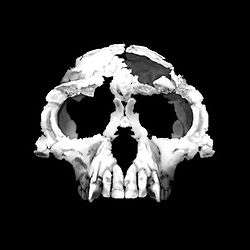

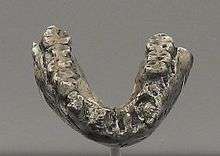
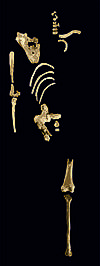
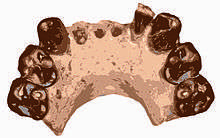
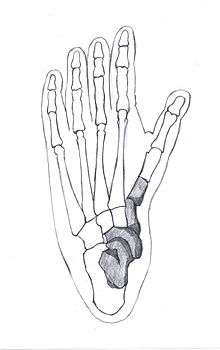
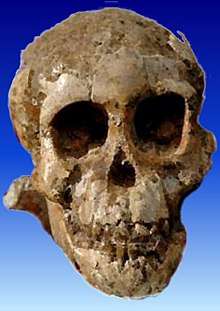
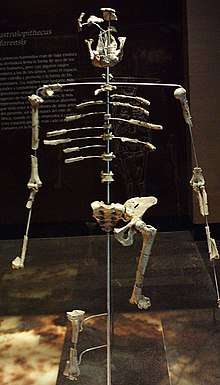
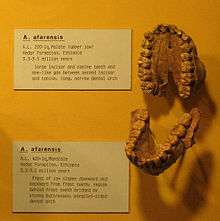
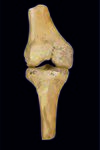

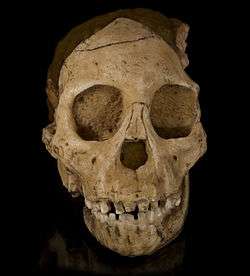
.jpg)

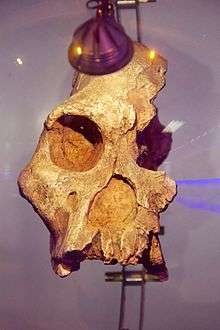

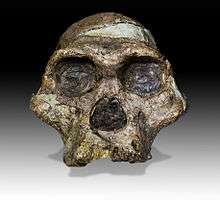
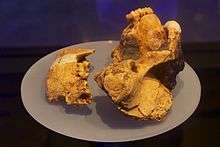
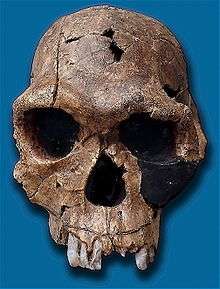

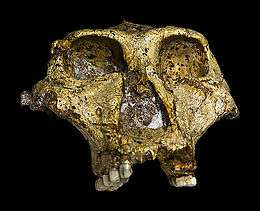
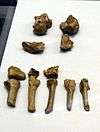
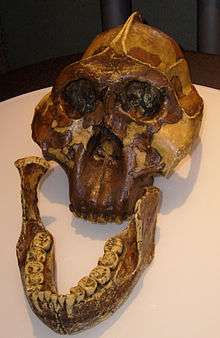
.jpg)

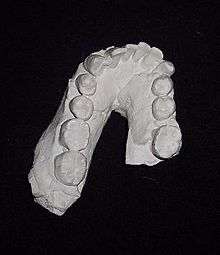
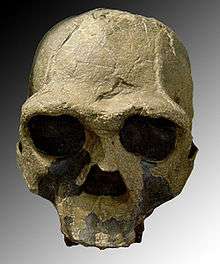
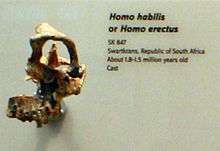
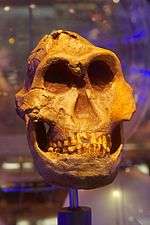
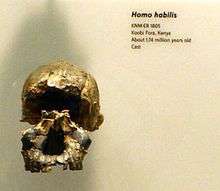
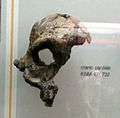

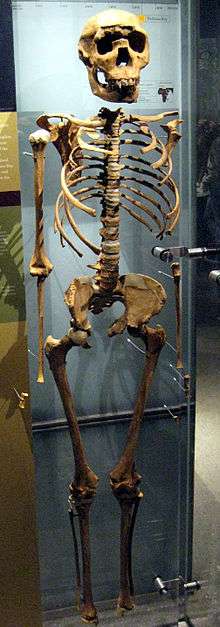
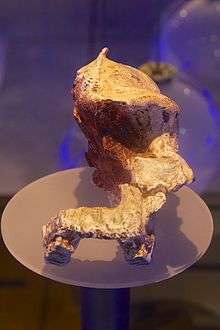
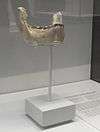
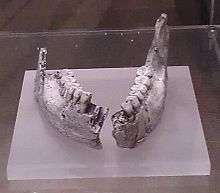



.jpg)
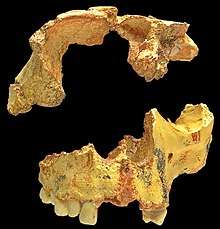
.jpg)


_presented_at_Paleozoological_Museum_of_China.jpg)

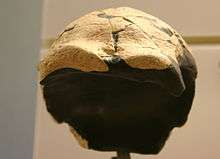
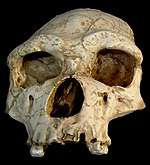

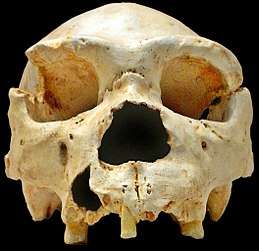

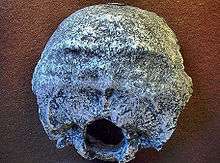

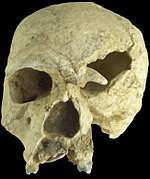
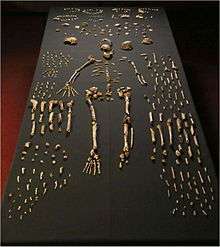
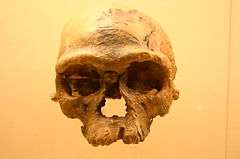
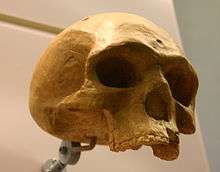
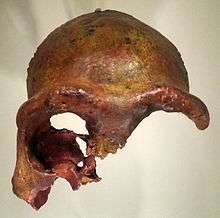


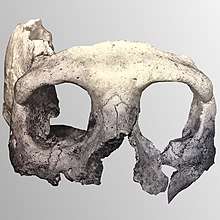




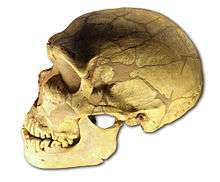

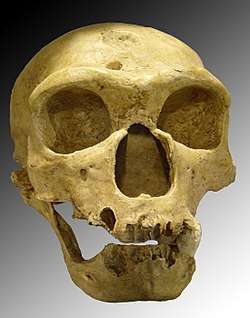
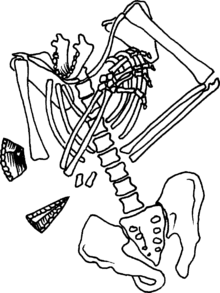
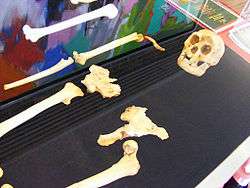

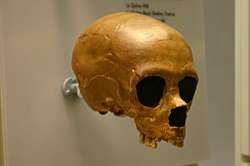
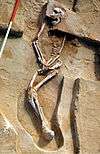

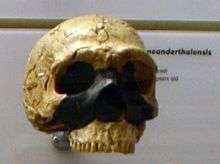
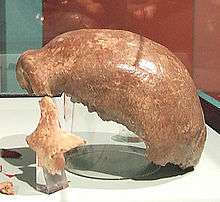
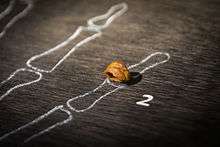


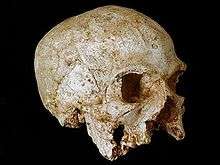
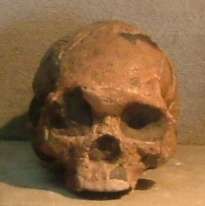
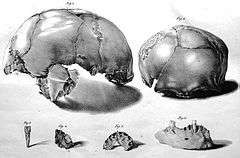
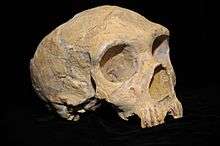
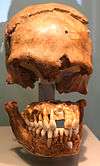
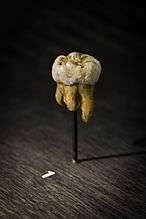
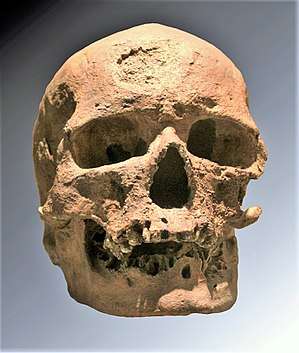
.jpg)
